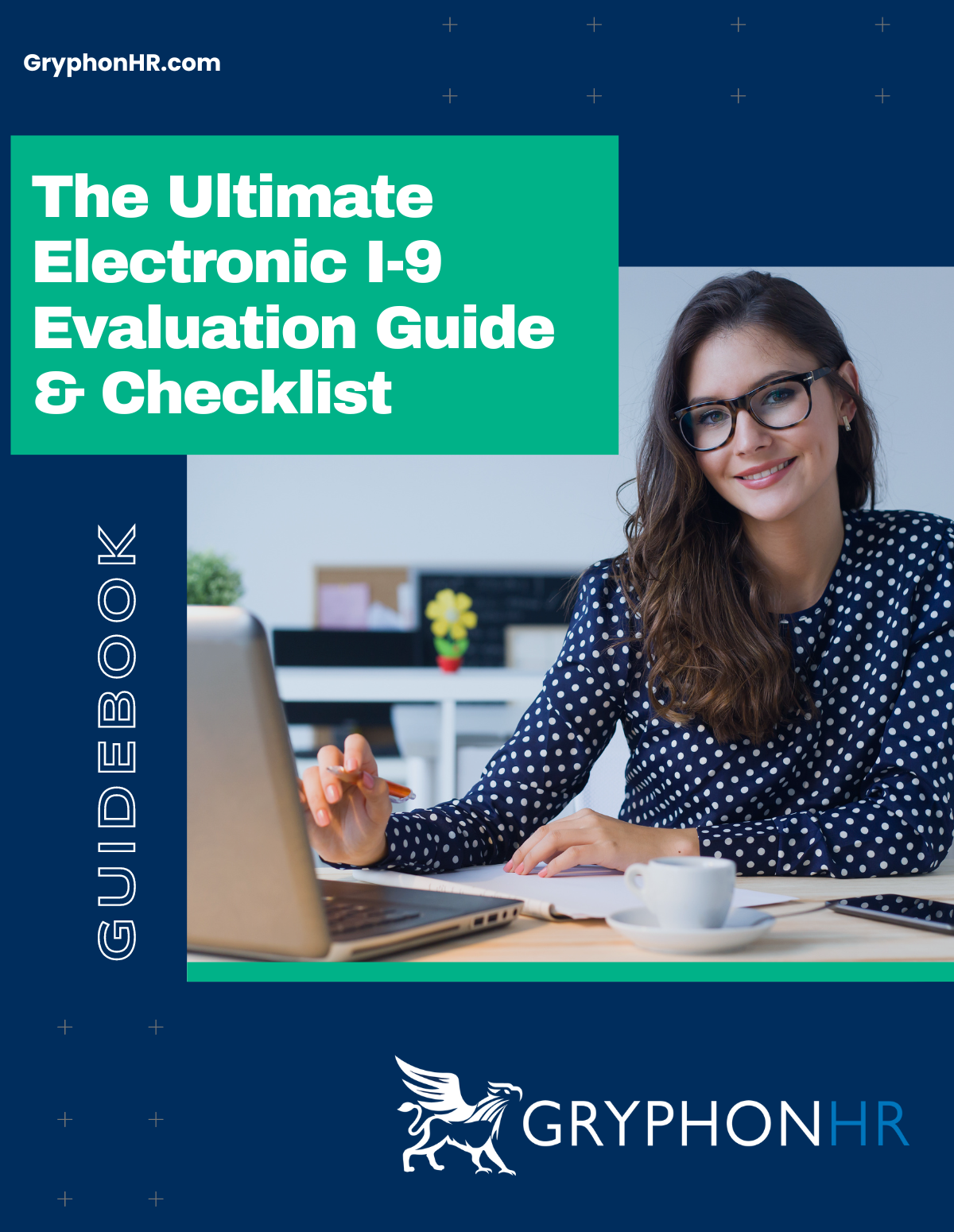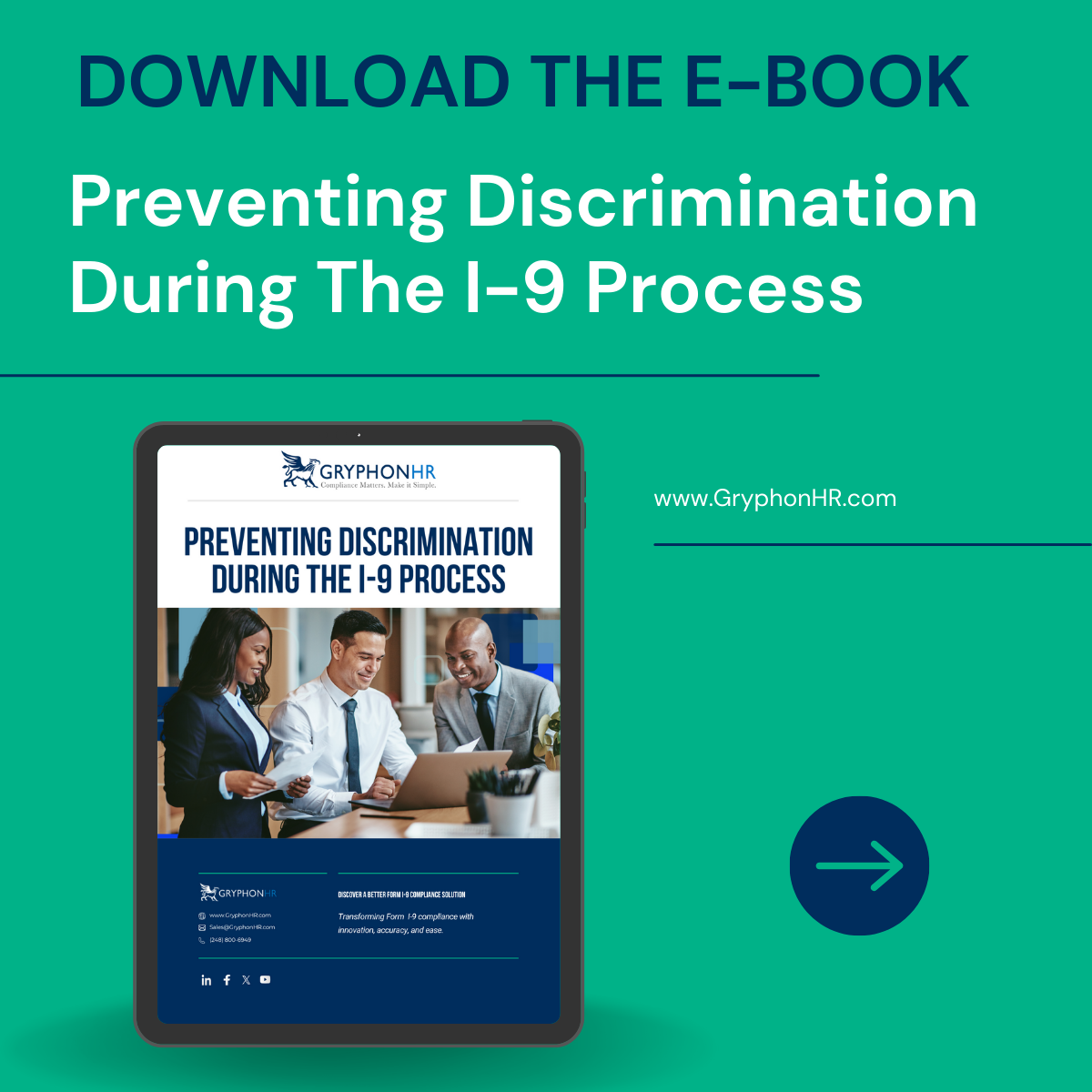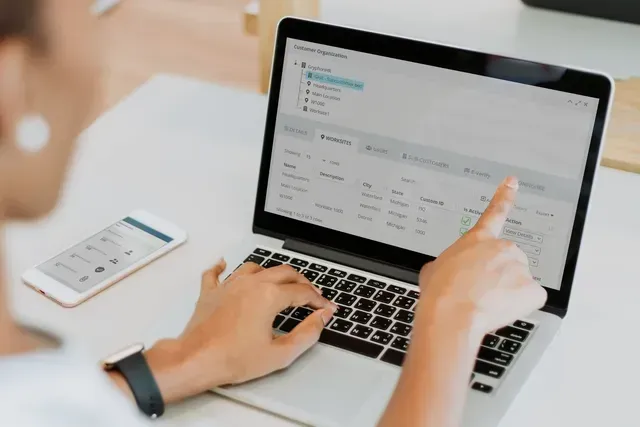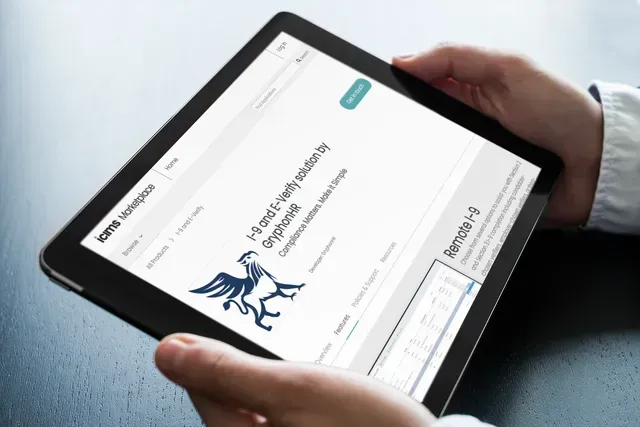Authored By: GryphonHR Blog Contributor
GryphonHR blog contributors include , consultants, researchers, and other subject-matter experts who’ve written content for our blog.
March 29, 2024
Whether you're deeply involved in various HR tasks or at the helm of an HR department, you're aware of the significance of modernizing and streamlining daunting employment processes. This includes leveraging solutions that help your team stay organized and compliant with employment laws. Adopting new HR technology can simplify complex procedures and requirements, especially digital solutions for Form I-9 compliance.
Transitioning to an electronic I-9 compliance system isn't just a nice addition—it's an essential step forward. This transformation has significantly changed how companies meet I-9 compliance regulations to ensure employees are legally authorized to work in the U.S. However, this change goes beyond merely replacing paper forms with digital versions. It's about enhancing the entire process, ensuring full compliance with changing legal requirements, and tailoring the system to fit the specific needs of your organization.
When we talk about switching to electronic I-9 solutions, compliance isn’t just part of the conversation—it’s the headline act. There are several requirements for electronic I-9 systems, including digital signatures and storage, as outlined by U.S. Citizenship and Immigration Services (USCIS). The Department of Justice and USCIS released a joint fact sheet outlining critical aspects of avoiding discrimination when using I-9 software. The right solution doesn't just digitize forms; it encapsulates a deep understanding of Form I-9 regulations, ensuring that every digital signature, audit trail, and piece of stored data adheres to stringent legal standards. Credibility comes from a solution's ability to demonstrate not just functionality, but an embedded compliance framework designed to adapt to regulatory changes, the needs of your business, and advancements in technology and security.
You’ve probably seen those all-in-one platforms that promise to take care of every HR need under the sun, including electronic I-9. They sound great, right? The problem is their broad-brush approach tends to skim over the nitty-gritty details that are crucial for nailing I-9 compliance. These platforms might cover the basics, but they often lack the depth needed for diverse types of businesses, especially when it comes to tailoring the system to fit specific needs or making sure remote verifications are managed just right.
All-in-one HR platforms that aim to cover every HR need, including electronic I-9 compliance, can seem appealing because they offer a wide range of services in one package. However, when it comes to the specialized needs of Form I-9 compliance, these platforms often fall short. The complexity of ensuring that employees are legally authorized to work in the U.S. demands more than a generic approach. All-in-one systems offer a broad spectrum of services, which can lead to a superficial handling of complex compliance issues.
A dedicated electronic I-9 system outperforms an all-in-one solution due to its exclusive focus on compliance with I-9 regulations. These dedicated systems are designed to deal with the nuances of Form I-9, including document verification, audit trails, and keeping up with legal standards. This focus means organizations can support compliance more easily and with a lower risk of costly errors.
Dedicated I-9 solutions offer greater customization to meet an organization's unique needs. Unlike all-in-one solutions, which often adopt a one-size-fits-all approach, dedicated systems can be tailored to meet organizational structures or workforce configurations. This is crucial for businesses with unique requirements, such as those with many remote workers or high employee turnover.
Integration without sacrificing specialization is another key benefit of dedicated electronic I-9 systems. These systems are designed to work seamlessly with a company's existing HR software, payroll systems, and onboarding platforms, creating a streamlined workflow that doesn't compromise compliance depth. This allows HR departments to use their preferred tools for various tasks while relying on a specialized system for I-9 compliance.
Another challenge that you may meet with all-in-one or bundled solutions is obtaining timely support when it's most needed. Limited resources dedicated to I-9 compliance can lead to frustration due to unresponsive support, further complicating the process for employers seeking to navigate I-9 compliance effectively.
Dedicated electronic I-9 systems are backed by providers with deep expertise in employment eligibility verification, as well as an understanding of how to best help your team and employees navigate Form I-9 and E-Verify. This experience is reflected in the I-9 software’s functionality in addition to a knowledgeable support team familiar with the nuances of I-9 compliance. You may find that support from all-in-one platforms lacks the depth needed to address complex I-9 issues effectively and promptly.
Beyond the issue of slow support response, a major reason employers opt for a dedicated electronic I-9 system is that they are more agile with quickly updating features and compliance protocols in response to new regulations. All-in-one solutions, with their broader focus, might not be as quick to implement necessary changes, potentially leaving organizations at risk of falling out of compliance.
While all-in-one HR solutions offer the convenience of handling multiple functions within a single platform, the specialized requirements of Form I-9 compliance are better served by a primary electronic I-9 system provider. This approach ensures a higher level of compliance with less risk and provides the flexibility, customization, and expert support needed to effectively manage employment verification.
The shift to remote work isn’t just changing where and how we do our jobs—it’s also changing how companies make sure their team members are legally allowed to work. With more people working from home and away from HR worksites, conducting I-9 verifications to complete Section 2 of Form I-9 shouldn’t be challenging. That’s where specialized I-9 solution providers come into play, making it easier for companies to stay on the right side of the law, no matter where their workers are based.
The alternative document verification procedure, now available for employers enrolled in E-Verify, introduces the capability for virtual verification of I-9 documents via live video conferencing. This process allows employers to remotely inspect work authorization and identification documents to complete Section 2 or for reverification. An advanced I-9 system not only streamlines this virtual process but also enhances the efficiency of in-person verifications for employers who need to verify documents with the employee physically present.
Several providers enable the use of authorized I-9 representatives who can meet employees at a convenient location to review their documents and complete the I-9. However, flexibility in choosing verification options without incurring added fees or needing extra apps is not a service all I-9 vendors offer. All-in-one providers often find it challenging to offer a seamless workflow that easily facilitates the verification of I-9 documents and the management of Form I-9 for employees, regardless of whether they are on-site or remote. Additionally, these providers may struggle to stay compliant with changing regulations and might charge extra for remote I-9 management tools, treating them as add-ons to their electronic I-9 services.
Figuring out the best electronic I-9 solution for your business means taking a step back and looking at the big picture. What does your company need? How complex is your setup? Here’s how to tackle it:
1. Assess Your Needs: Start by getting a clear picture of what your organization looks like and what you are up against when it comes to employment verification processes.
2. Compliance is Key: Any electronic I-9 system you pick must meet USCIS standards for compliance, and it should be designed to adapt to changing regulations.
3. Customize to Fit: Make sure the system you go with can accommodate the unique needs and structure of your business.
4. Think Big Picture: Your business is not standing still, and your electronic I-9 system shouldn’t either. Choose a solution that can grow and evolve with you.
The journey to a more efficient, compliant, and remote-friendly electronic I-9 verification process is packed with challenges, from keeping up with regulations to making sure the system works for your specific business. While those all-in-one solutions might seem convenient, they often miss the mark when it comes to the specifics of I-9 compliance. That’s why platforms focused solely on compliance, like specialized I-9 solutions, are so valuable.
You might feel tethered to your existing HR tech stack, onboarding platform, or another HR system due to contract obligations or the daunting prospect of transitioning to a new system—from implementation and training to IT support, legal vetting, and establishing security protocols. However, adopting a superior I-9 solution doesn't have to be an ordeal. A proficient I-9 provider can streamline the transition, equipping you with the necessary tools and support to ensure your success. It is crucial to weigh the risks associated with sticking to cumbersome, non-compliant systems prone to errors. This is where GryphonHR comes into the picture, offering a seamless transition without the headaches. Our team of experts is adept at managing the complexities involved in such transitions. We specialize in aligning with your organization's unique requirements and teams, ensuring a smooth onboarding process. All it takes is your readiness to make the move.
Navigating through the sea of electronic I-9 solution providers can be overwhelming, right? Back in the day, choosing one may have seemed easier because there weren’t as many around. But now? It’s like a new I-9 company or product pops up every other day, each one promising the moon. And after a while, they all start to sound the same, making you wonder how you’re supposed to pick the right one.
So, how do you cut through the noise and choose? Well, it’s all about focusing on what truly matters to your organization. Look beyond the fancy features and flashy tech. Consider the provider's experience, customer support, and how well their solution adapts to your specific needs. Sometimes, it’s those subtle differences in service and support that make all the difference. And remember, a conversation with existing customers can reveal a world of insight.
Selecting the ideal electronic I-9 solution is far from a minor task on your checklist—it's a pivotal move that primes your business for success. Why not start with our free interactive guide? No forms to fill — download "The Ultimate Electronic I-9 Evaluation Guide".
Thinking we might be nudging you a bit towards considering
GryphonHR for your I-9 needs? Well, you've got us there. Sure, this piece aims to shed light on the real issues surrounding I-9 compliance and the spectrum of solutions out there, but we're also hoping to help you cut through the clutter. We're not shy about it: we'd love for you to choose us. We're confident in our ability to offer an I-9 solution that both your team and your employees will appreciate, one that not only helps to ensure compliance with Form I-9 regulations but also enhances your overall experience. Still on the fence?
Reach out to us, ask your questions, and take a closer look at what our platform has to offer.

Authored By: GryphonHR Blog Contributor
GryphonHR blog contributors include , consultants, researchers, and other subject-matter experts who’ve written content for our blog.
Stay updated on Form I-9 and E-Verify!


Is your I-9 compliance software placing you at risk? Learn more about the compliance requirements for electronic I-9 systems and how to evaluate important features. Skip the form and download this interactive guide!

Avoiding discrimination during the Form I-9 process is critical to preventing liability, hefty fines, and unfair hiring practices. Download our free e-book to learn more.



MENU
STAY CONNECTED
Join our newsletter to learn more about Form I-9.